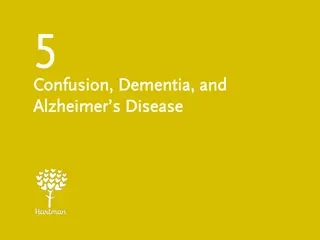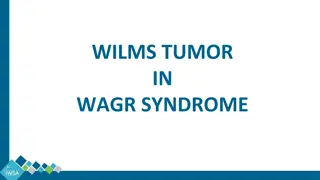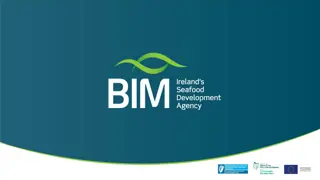Understanding Organic Brain Syndrome & Delirium
Overview of organic brain syndrome and delirium, including definitions, clinical features, and management. Delirium, a common psychiatric syndrome, affects consciousness, cognition, and perception, leading to increased morbidity and mortality. Recognize core symptoms, such as disturbances in consciousness and cognition, with fluctuating patterns. Multiple names such as ICU psychosis and acute confusional state are also used. Pathophysiology involves neurochemical, metabolic, and immune system alterations.
Download Presentation

Please find below an Image/Link to download the presentation.
The content on the website is provided AS IS for your information and personal use only. It may not be sold, licensed, or shared on other websites without obtaining consent from the author. Download presentation by click this link. If you encounter any issues during the download, it is possible that the publisher has removed the file from their server.
E N D
Presentation Transcript
ORGANIC BRAIN SYNDROME (DELIRIUM AND DEMENTIA) DR.BANDNA GUPTA MD ASSISTANT PROFESSOR DEPT.OF PSYCHIATRY
ORGANIC BRAIN SYNDROME Organic brain syndrome (OBS) is a general term used to describe decreased mental function due to a medical disease, other than a psychiatric illness. Organic, including symptomatic, mental disorders (as per ICD-10) F00 F01 P02 F03 F04 Dementia in Alzheimer s disease Vascular dementia Dementia in other diseases classified elsewhere Unspecified dementia Organic amnesic syndrome, not induced by alcohol and other psychoactive substances Delirium, not induced by alcohol and other psychoactive substances Other mental disorders due to brain damage and dysfunction and to physical disease Personality and behavioral disorders due to brain disease, damage and dysfunction Unspecified organic or symptomatic mental disorder F05 F06 F07 F09
DELIRIUM- CLINICAL FEATURE AND MANAGEMENT
What is Delirium Delirium is derived from the Latin verb deliro to be crazy. Diagnostic and Statistical Manual of Mental Disorders (DSM-IV-TR) defines delirium as follows: Foremost a disturbance of consciousness, attention, cognition, and perception. It is a common psychiatric syndrome which commonly heralds an increase in morbidity and mortality. Patients with delirium remain in the hospital longer and are more commonly discharged to long-term care facilities.
DELIRIUM (CONTD.) The core symptoms of delirium include: A disturbance of consciousness that is accompanied by a change in cognition Develops over a short period of time, usually hours to days, and Tends to fluctuate during the course of the day. Degree of difficulty in these areas may be greater or less over the course of the day, but overall, delirium represents a sudden and significant decline from the previous level of functioning. Delirium is usually temporary and reversible and does not reflect a persistent psychiatric disorder
Also Known As Intensive care unit psychosis Acute confusional state Acute brain failure Toxic metabolic state Central nervous system toxicity Sundowning Cerebral insufficiency Organic brain syndrome
Pathophysiology The pathophysiology of the syndrome is not well understood. Because of heterogeneity of the etiologies and the presentations of delirium, there may not be one mechanism The proposed theories for delirium pathophysiology involve- Neurochemical abnormalities, Alterations in metabolism, Involvement of cytokines and acute phase reactants, and Changes in the permeability of the blood brain barrier. These systems are not mutually exclusive and may have considerable interactions.
Delirium: Clinical Features FLUCTUATING LEVELS OF CONSCIOUSNESS ATTENTION IMPAIRMENT DISORIENTATION MEMORY IMPAIRMENT SLEEP DISTURBANCE AGITATION EMOTIONAL LABILITY
Subtypes of Delirium 1.Hyperactive. Patients here are agitated, disoriented,and delusional, and may experience hallucinations. This presentation can be confused with that of schizophrenia, agitated dementia, or a psychotic disorder. 2.Hypoactive. Patients in this subtype are subdued,quietly confused, disoriented, and apathetic. Delirium in these patients may go unrecognized or be confused with depression or dementia. 3.Mixed. This is characterized by fluctuations between the hyperactive and hypoactive subtypes.
Diagnosing the delirium Diagnostic Criteria for Delirium A. Disturbance of consciousness (i.e., reduced clarity of awareness about the environment) with reduced ability to focus, sustain, or shift attention. B. A change in cognition (e.g., memory deficit, disorientation, language disturbance) or development of a perceptual disturbance that is not better accounted for by a preexisting, established, or evolving dementia.
Diagnosing the delirium C. The disturbance develops over a short period of time (usually hours to days) and tends to fluctuate during the course of a day. D. Evidence from the history, physical examination, or laboratory findings indicate that the disturbance is caused by direct physiologic consequences of a general medical condition.
Management of Delirium The diagnosis of delirium is made clinically through history, physical examination, mental status examination, serial observation of the patient History and General Examination History Onset and features Baseline or history of underlying dementia, neurological conditions (stroke, seizures) Risk factors for delirium General medical illnesses / medications General Examination (Emphasis) B.P., Pulse, Temperature, pallor, icterus, cyanosis, clubbing, lymphadenopathy, edema trauma
Management of Delirium Systemic examination RESPIRATORY SYSTEM : Tachypnea, rales, irregular rate. CVS ABDOMEN CNS: Language Deficits, Fundoscopic Exam (Papilledema), Pupils, Ocular Movements (Nystagmus), Focal Motor/Sensory/ Coordination Deficits.
Screening Tools Folstein Mini-Mental State Examination (MMSE) : to assess improvement The Memorial Delirium Assessment Scale (MDAS) : measure the severity 1) 2)
INVESTIGATION CBC with Differential; CXR, blood and urine cultures, RPR Full electrolytes / LFTs / Possible NH3 Nutritional (B12, folate, thiamine) Toxicology Screen/Drug Levels Pulse-ox / ABG CNS imaging- CT first if focal findings EEG (Slowing in delirium; evaluate for asymmetric patterns, epileptiform discharges, triphasic wave forms) Lumbar Puncture if there is evidence for increased ICP, S/O Meningitis
Treatment should be focused on Identifying the cause and Management then treating it! There are three major goals of delirium treatment. One is to find and to reverse the contributors to the delirium. The second is to ensure the patient's safety while educating patients, family, and staff The third is the symptomatic treatment of behavioral disturbances associated with delirium. Management can be divided in to Pharmacological Non-pharmacological
PHARMACOLOGICAL Pharmacological and other somatic treatment Treatment of underlying medical condition Antipsychotics Antipsychotics may be considered if psychosis, severely disorganized thought process, or extreme physical or verbal agitation places the patient or others at risk of harm Low-dose, high-potency antipsychotic agents have been the most frequently studied agents in the treatment of delirium.
PHARMACOLOGICAL They may benefit an agitated patient by allowing completion of diagnostic tests and protecting the patient and others from harm. Agents such as haloperidol have the longest track record in delirium management and may be given orally, intramuscularly (IM), or IV.
NON -PHARMACOLOGICAL Non-pharmacological management ENVIRONMENT & SUPPORTIVE MANAGEMENT 1.Providing support and orientation communicate clearly, repeated verbal reminders Signpost such as clock, calendar Familiar objects from patients home in room Consistency in staff Involve family for feeling of security and orientation 2. Providing an unambiguous environment Remove unnecessary objects, adequate space b/w beds Avoid using medical jargon in patients presence, may induce paranoia Adequate lightening, control excess noise
NON -PHARMACOLOGICAL 3. Maintaining competence Identify and correct sensory impairment like glasses, hearing aids Encourage self care and participation in treatment Allow maximum uninterrupted sleep Maintain activity levels : ambulatory patients should walk 3 times a day and non ambulatory should undergo full range of movements for 15 minutes thrice a day
NON -PHARMACOLOGICAL 4. Patient and Family Education- Families can be educated as to appropriate ways to be supportive to the patient, as well as to what information is important to convey to the medical team. As the delirium symptoms resolve, the patient and family should be educated about the long-term prognosis. The knowledge about delirium's risk of increased mortality and functional and cognitive decline may be shared with the patient and family as clinically appropriate.
Definition Dementia is a syndrome manifested by several cognitive deficits that include memory impairment involving at least one of the following: Aphasia (language disturbance), Agnosia (inability to carry out motor Activities despite intact motor function Apraxia (failure to recognize or identify objects despite intact sensory function) interferes with social, occupational, or interpersonal skills.
Additional features Emotional lability Impairment of intellect Mood, personality, judgment, and social behavior Thought abnormalities Urinary and fecal incontenence Disorientation Neurological signs +/-
PNEUMONICS OF POSSIBLE CAUSES D= Drugs, Delirium E= Emotions (such as depression) and Endocrine Disorders M=Metabolic Disturbances E= Eye and Ear Impairments N=Nutritional Disorders T= Tumors, Toxicity, Trauma to Head I= Infectious Disorders A= Alcohol, Arteriosclerosis
Possible Etiologies of Dementia Degenerative dementias Alzheimer's disease Frontotemporal dementias Parkinson's disease Lewy body dementia Miscellaneous Huntington's disease Wilson's disease Psychiatric Pseudodementia of depression Cognitive decline in late-life schizophrenia Physiologic Normal pressure hydrocephalus Metabolic Vitamin deficiencies (e.g., vitamin B12, folate) Endocrinopathies (e.g., hypothyroidism) Chronic metabolic disturbances (e.g., uremia)
Possible Etiologies of Dementia Tumor Primary or metastatic Traumatic Posttraumatic dementia Subdural hematoma Infection Prion diseases (e.g., Creutzfeldt-Jakob disease Acquired immune deficiency syndrome (AIDS) Syphilis Cardiac, vascular, and anoxia Infarction Hemodynamic insufficiency (e.g., hypoperfusion or hypoxia) Demyelinating diseases Multiple sclerosis Drugs and toxins Alcohol Irradiation Pseudodementia due to medications (e.g., anticholinergics) Carbon monoxide
DIAGNOSIS According to the ICD-10 the following features are required for the diagnosis:- 1)evidence of decline in both memory and thinking,sufficient enough to impair personal activities of daily living. 2)Memory impairment typically affects the registration, storage and retrieval of new information(recent memory)but previously learned material(remote memory) may also be lost, particularly in later stages.
DIAGNOSIS(contd.) 3)Thinking is impaired, the flow of ideas is reduced, and the reasoning capacity is also impaired. 4) Presence of clear consciousness.(Consciousness can be impaired if delirium is also present). 5) Duration of at least 6 months.
Features Cortical dementia Subcortical dementia 1.Site of lesion Cortex Subcortical grey matter (thalamus,basal ganglia,brain stem) 2.Examples Alzheimer s disease Pick s disease Huntington chorea Parkinson s disease 3.Severity Severe Mild to moderate ` 4.Motor system Usually normal Flexed\Extended posture, Tremors, chorea 5.Other features Depression uncommon. Severe aphasia,amnesia,agnosia, Delusions, depression rarely mania
Normal vs AD Brain Normal brain Alzheimer s brain
Basic Investigations CBC Urinalysis Blood glucose Electrolytes RFT, TFT, Arterial PO2/PCO2 Chest x-ray,EEG,LP, CT/MRI, Drug level
Treatment Pharmacological Rx the underlying cause. Cholinesterase inhibiters (Donepezil, rivastigmine, galantamine), Mementine. Prevention of vascular risk factors. Citolapram, sertraline for depression. Antipsychotics (haloperidol, risperidone) or/and benzodiazepines( short and intermediate acting) for behavioral problems.
Non- pharmacological Multidisciplinary assessment. Psychoeducation of family members. Family support. Cognitive stimulation.























